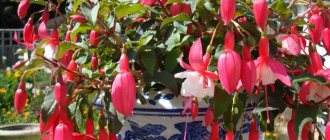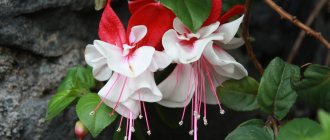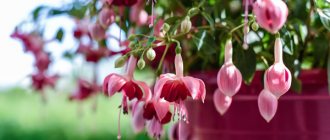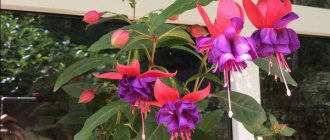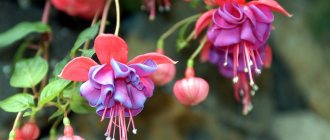Soil for fuchsia
For any plant, properly selected soil is the key to health, adequate nutrition, moisture and ventilation of the roots.
Fuchsias prefer light, nutritious soil with good drainage and a neutral or slightly acidic reaction.
Theoretically, almost any purchased universal soil is suitable, especially after adding sand. But in practice, its quality often leaves much to be desired: at best it will be pure peat, which shrinks too much when drying and quickly loses nutrients. At worst, you can get a lot of debris, and even weed seeds and spores of pathogenic fungi along with the substrate. Universal substrates from manufacturers “Rich Land” and “Compo San” are praised.
There are several options for homemade soil mixtures for fuchsias:
Sod is a cut of the top layer of soil (10 - 12 cm) from pastures, which has been rotted for 6 - 8 months. Due to the remnants of grass root fibers, which completely decompose after about 2 years, it does not caking and retains water. It can be loamy, less often sandy loam, it depends on the source material. Loamy soil is heavier, so when using it, you can increase the proportion of peat or leaf humus, and together with sandy loam, less sand and more fertilizers are used. Before use, it should be barely damp and easy to crumble.
Peat is a natural fossil, formed from dead plants under high humidity and lack of oxygen. It has a very high ability to absorb water, so if you bought it completely dried, moisten it a day before use. It’s better to buy granular – it gives the substrate structure and lightness. Use well moistened.
Leaf humus is leaves of trees rotted during the year, preferably oak or beech; the finished humus must pass through a garden sieve. Can be replaced with soil from under the appropriate trees, or, if not possible, with peat. It contains few nutrients, but improves the structure, breathability and moisture capacity of the soil.
Sand also improves soil structure, adds weight and creates a barrier for roots so they occupy the middle of the pot and not just circle around the perimeter. We strongly do not recommend fine quarry sand - it tends to cake into hard lumps when wet. The best choice is washed river coarse grain. Can be replaced with highly crushed clay shards.
Coconut soil is new to most gardeners. It is made from coconut shells, sold dry, pressed into briquettes, and when wet it swells greatly. It has a high moisture capacity and content of microelements, and decomposes for a very long time. Such soil is almost impossible to fill, and this is valuable for fuchsias. It can occupy up to 50% of the substrate; the rest can be supplemented with ordinary garden soil with the addition of sand or vermiculite.
Dry sphagnum moss is also added instead of peat or together with it (accounting for its share in the substrate) - it also ensures lightness and airiness of the soil.
In addition to these ingredients, fertilizers, vermiculite, pine needles, charcoal, ash, rotted manure (for fertilizer), hydrogel (a quarter of a teaspoon per medium pot, it is very moisture-absorbing) or crushed coconut fiber are added to the substrate.
2-3 cm of perlite, charcoal or other drainage is poured onto the bottom for drainage.
Tips for caring for fuchsias from Alla Zinchuk
Home / Club / StoriesI read Natasha’s note.
I wanted to add on my own. Many people write to me asking for advice on caring for fuchsias. Unfortunately, we have almost no information on this topic. There is a lot of interesting and useful information on Western websites, but not everyone has access to it. Therefore, I will try to briefly outline what I was able to glean from them, as well as from my own experience. I got sick of fuchsias a long time ago, but I really started growing them only last year. Over the course of a year, I managed to assemble a collection of about 40 varieties. It’s unlikely that I would have been so successful if it weren’t for the Internet. Therefore, I want to thank everyone who responded to my call when I was looking for the first cuttings! During the year I had to experience both joys and disappointments. Especially during the heat that hit Moscow in July-August last year. To avoid such disappointments, you need to know a few “secrets”. This is what I will try to share with you.
Reproduction
Almost any part of fuchsia (except flowers) is suitable as a material for propagating fuchsia.
Most suitable for this purpose are mature but not yet lignified cuttings about 10 cm long with three pairs of leaves. The lower leaves are removed, and the cuttings are placed in a vessel with water or immediately planted in loose soil with a high content of sand or vermiculite (growth stimulants can be used). To protect the cuttings from excessive evaporation, they should be covered with a plastic bag or some kind of jar. Cuttings standing in water can also wither, then they should be sprinkled with water (you can completely immerse them in a container of water for a couple of hours) and also wrapped in similar material. Cuttings must be protected from the sun and overheating and ventilated periodically. You can easily see the appearance of roots of cuttings in water. Cuttings planted in the ground can be considered rooted when they begin to grow. After this, the shelter must be gradually removed. In the same way, you can root the green tips of the shoots, which are usually thrown away when pinched. Recently I heard that you can root even large leaves that are cut off from the main shoot along with the axillary bud. Transplantation
For replanting, take small pots. It is believed that it is better to transfer the plants several times to larger pots as they grow. If you are replanting an adult plant in the spring, then the earthen ball should be reduced by 1/3 and the plant should be planted in a smaller pot. It is imperative to make good drainage (I take pieces of charcoal) - fuchsias do not tolerate stagnant water. The soil needs to be nutritious, but loose (this is achieved by adding sand or vermiculite). When replanting, the soil should never be compacted; simply knock the pot so that the soil settles and fills the voids, and water. For some time after transplantation, until the plant takes root well, it is not recommended to water it. To preserve moisture, you can cover it with polyethylene.
Pruning and crown formation
To form a bush and obtain a large number of shoots (and, consequently, flowers), fuchsias need pinching. I, of course, understand that you will feel sorry for them, but the tops of rooted and established cuttings need to be pinched, and then all the side shoots above the third pair of leaves should be pinched. Then you will have strong, lush bushes. The same applies to mature plants, which are pre-pruned in late autumn or early spring. After the last pinching, fuchsias bloom in 6-8 weeks, depending on the variety. You can, of course, stop pinching.
Watering
And the most important thing is watering.
It is necessary to water the plants evenly, but under no circumstances overwater them. 90% of fuchsias die from being flooded. Moreover, you may not notice this right away. The plant may look quite healthy for a few more days, and then suddenly drop its leaves and die. This is especially dangerous in hot weather, when you want to water it better, and in cool weather, when watering exceeds the amount of liquid that can evaporate. It is better to spray the plants more often, and water only as needed. Rooted cuttings and recently transplanted plants need especially moderate watering.
Fuchsia fertilizers In the spring, you need to apply a complex fertilizer with a high nitrogen content weekly in small quantities, and after the buds appear, phosphorus and potassium. It’s better to splurge and buy “Pocon for geraniums and flowering ones”; the results will not be long in coming. Although, many Western lovers write that fertilizers for tomatoes are also good. I bought the fertilizer “Ripe! For peppers and tomatoes" and alternated it with "Pokon"
Pests
In my opinion, fuchsias are quite resistant to pests. The only concern is the whitefly. It is very easy to fight it in the following way: there is a Swiss powder called “AKTARA”. Completely odorless, hazard class - 3. Sold in 4 g bags. Dilute the bag with 5-10 liters of water and water the plants little by little at the root, making sure that the liquid does not spill through the drainage hole. First, the soil must be thoroughly wetted. Then you don’t water it for three days. In a few days you will forget about the whitefly. If the plant is severely damaged, it is recommended to first wash it thoroughly, and then you can spray the leaves with the same solution.
If you receive cuttings with numerous black dots visible on the underside of the leaf (these are whitefly eggs), light green small larvae or white flies, rinse the cuttings under water, and then root them in the ground, mixing a pinch of Aktara into it and covering it with plastic package. As the cuttings take root, they will begin to absorb the drug from the ground, and the whiteflies will gradually die—then the shelter can be removed. If a spider mite has its eye on the flowers, spray with Fitoverm.
Good luck!
Alla Zinchuk
Allina’s collection of indoor plants can be seen in the “Flower Collections” section, and in the “Flowers Stories” section she gives advice on growing plants on a glassed-in loggia.
Fertilizers and fertilizers
In order to correctly calculate the dose and understand what kind of feeding the plant needs, you now need to be a professional.
Moreover, if you have already applied liquid fertilizers, the plant is forced to absorb them, even if it is harmful. Therefore, it is better to add balanced nutrition to the substrate - it should be enough for a year, or even two, until the next transplant. You can prepare such a dry fertilizer mixture yourself. To do this, for 24 liters of substrate take:
Mix all ingredients separately from the substrate, add before planting: in the indicated doses (6g of mixture per liter of substrate) - for rooted young plants (pot diameter - 10 - 15 cm), for juveniles - reduce the dosage by 2 times, and for large plants - increase 1.5 times.
When applying any fertilizers (either these or liquid ones), remember that they oxidize the soil, which must be neutralized with lime, or better yet, with seaweed petrified to the state of limestone, at the rate of 1 - 1.5 g per 1 g of fertilizer.
With this scheme for enriching a properly composed substrate, liquid fertilizing will be required only for adult plants that no longer change the pot.
Alternative fertilizer options include river silt (rich in nitrogen and microelements, can replace horn and hoof meal) or dry fish fertilizer (40 ml per 7 liters of substrate for adult plants).
Source
Decorative fuchsia flower on your window! Photo, planting and care
Fuchsia is a perennial shrub native to South America. The indoor plant retains its need for high humidity and moderate temperatures. Abundant flowering continues from April to October.
Growing fuchsia at home requires compliance with the rules of agricultural technology. How to plant fuchsia, possible care problems - read on.
Possible difficulties during cultivation
The larger the plant, the more capricious it is. Some gardeners face certain problems when growing fuchsia:
- A large number of lower leaves fall and wither. This is caused by regular drying out of the soil.
- Greens and buds are falling off the bush. This is how the plant reacts to increased air temperature.
- There is no flowering, the shoots stretch out and become thin. This state of the flower is the result of insufficient lighting.
- The newly opened buds quickly fall off. The reason for this may be a lack of nutrients in the soil or keeping the plant in warm conditions in winter.
- The flower suddenly began to drop its buds. This reaction is possible to changing the location of the pot during flowering.
The fuchsia flower, the care of which consists of following simple rules of agricultural technology, is a precious exhibit for any gardener. Even a beginner can handle maintaining the plant, and the time and effort spent is more than compensated by the bright, long-lasting flowering.
How to plant at home?
A purchased plant or a cut cutting of a fuchsia flower will take root and begin to grow if the planting and care rules are followed. The health of the plant depends on the selected soil and maintenance conditions.
Which pot to choose?
Every year, when replanting, the size of the pot increases by 2-3 cm. The root system of the flower should completely entwine the earthen ball. Free soil turns sour, causing roots to rot.
Recommended material: ceramics, light color. Such a pot will not overheat in the sun. In dark plastic, the roots of the plant die under the influence of high temperature. There should be drainage holes at the bottom of the container.
Soil composition
Fuchsia requires a nutritious loose substrate with neutral acidity. A ready-made universal mixture for flowering plants is recommended.
To improve the structure, leavening agents are added to the soil - perlite, vermiculite, coconut substrate. If desired, prepare the soil yourself:
A drainage layer of expanded clay or small pebbles is poured onto the bottom of the pot. It will prevent water stagnation and soil erosion.
What should I do to get the shoot to take root?
The fuchsia shoot is rooted in soil or water. In order for the cutting to grow roots, it is required:
Covering with a glass jar or bag will ensure the required level of humidity. The shoot is ventilated daily and condensation is removed from the walls of the jar. The seedling is sprayed with water at room temperature. The appearance of new leaves after 2-3 weeks indicates successful rooting.
Location and lighting
A fuchsia pot is placed on east or west windows. On the north side it provokes weak flowering. The plant needs diffused lighting and fresh air. The best place for flowers is the balcony. During the flowering period, fuchsia cannot be touched or rearranged; it immediately drops its buds.
Temperature
Fuchsia tolerates cool temperatures well, but heat causes lethargy and drooping leaves. The optimal temperature during the growing season is 16-20°, in winter 10-11°. In summer, the flower is removed away from direct sunlight, which causes burns to the leaves and overheating of the roots.
Watering
Moistening the flower is the most important part of agricultural technology. Lack of water leads to drying out, and overwatering leads to rotting of the roots. Watering is carried out with settled water.
The volume and frequency of humidification depend on the temperature in the room, the volume of the pot, and the stage of development. The average is 100 ml per 0.5 liter pot, every 3-4 days. A little trick will help you determine the need for watering. A wooden stick is stuck at the edge of the pot; if it is wet and dirty, then it’s not time yet. If there are lumps of earth on the stick, it's time to moisturize.
Watering is partially replaced by spraying. While there are no flowers, the plant is periodically placed under the shower. In autumn, the amount of water is reduced. In winter, 1-2 waterings per month are sufficient.
Fertilizers
Fuchsia is a plant that requires regular feeding. A young flower needs fertilizer with a high nitrogen content. An adult plant requires complete feeding with phosphorus, calcium and other microelements. Applying complex fertilizers once a week will satisfy the needs of fuchsia. Foliar feeding with the drug "Bud" is effective during the flowering period. Mineral products alternate with organic ones.
The use of long-acting fertilizers Osmocote gives good results. The drug is buried in the soil above the drainage layer. Minerals are in capsules that gradually dissolve when watered. In the spring, to stimulate shoot growth, they are sprayed with magnesium sulfate (1 tsp per 1 liter of water).
Fertilizers can be applied daily with watering, reducing the recommended concentration by 6 times.
It is prohibited to feed:
Below you can see photos of fuchsia flowers:
How to choose the right seedlings in the store
Before you buy a plant, it is very important to pay attention to its condition. A healthy fuchsia has a well-leafed crown with matte green leaves. It is better to buy a plant during budding or during rest. Blooming fuchsia will not last long; as it takes root in a new place, it can shed its inflorescences.
When purchasing seedlings, carefully study the root system. The roots are white, without plaque or traces of fungus, and are considered suitable for planting. If the root system has already grown, then immediately on the day of planting it is trimmed to 10 centimeters.
Growing rules
The life cycle of fuchsia is divided into a period of activity (spring-autumn) and a period of rest (winter). During the growing season, the flower needs watering, light, and fertilizing.
Maintenance procedures include trimming and pinching. The first pinching is performed over 2-3 internodes of the cutting. The procedure is repeated as it grows. Trimming is done twice. Before wintering, remove faded branches. In early spring, dry shoots are removed, healthy tops are shortened by 1/3. After pruning, the flower is transplanted into fresh soil. Watering is rare, subcortexing stops in October. In spring, the bushes are returned to a bright windowsill and watered with warm water. The cuttings remaining after pruning are rooted in water or soil.
Read more about the rules for growing fuchsia here, and here we talked about the nuances of growing garden fuchsia.
Flower pruning in autumn
Autumn is the period when active flowering of fuchsia ends and the dormant period begins . Pruning during this period should be carried out immediately, as soon as the fuchsia has stopped blooming and has entered a dormant state. This contributes to good winter hibernation and successful spring awakening.
To do this you need:
- Carefully remove the bush from the pot and inspect it for diseases and parasites. You should remove the fuchsia carefully so as not to damage the roots that may have grown to the walls of the pot. It is better to throw away the old soil, as it may be infested with pests.
- Fuchsia should be cleared of parasitic insects and their eggs. Diseased roots, black, with a grayish tint, are cut off. You should trim with pruning shears, capturing the healthy root about a centimeter to prevent re-infection.
- The pot is thoroughly washed and disinfected.
- Next, you should fill in a new drainage and fresh soil, into which the flower is carefully placed.
After all the manipulations, you need to place the fuchsia in a dark, damp and cool place where the plant will spend the whole winter. This is a very important difference from spring transplantation, when fuchsia is left warm. In autumn and winter, the plant must rest and gain strength before the new growing season .
Do not allow the earthen ball to dry out and periodically water the plant with clean, settled water. There is no need to fertilize at this time.
Possible problems
Plant damage can be divided into two groups. Some are caused by improper care, while others are caused by infection with fungi or bacteria.
Content errors
Infectious diseases and pests
The most common disease of fuchsia is rust. The first sign of infection is brown spots on the back of the leaves. Rust spreads quickly; upon noticing the symptoms of the disease, the flower is isolated. Affected leaves are cut off and destroyed. The plant and soil are treated with Topaz.
Pests of indoor fuchsia are whiteflies and spider mites. The result of their vital activity is wilting and falling leaves. The insecticide “Aktara” or “Condifor” is used against whiteflies. Ticks are combated using Akarin and Fitoverm. 3 treatments will be required.
Errors in planting and growing affect the duration of flowering and the size of the buds. The light-loving shrub needs diffused lighting, an abundance of fresh air and moisture. In the summer, you need a place where the temperature will not exceed 20°. In hot weather, fuchsia sheds flowers and leaves.
If you find an error, please select a piece of text and press Ctrl+Enter.
Source
Tips for growing fuchsia
In nature, there are a great variety of beautiful flowers that can be grown at home. Many people's favorites are fuchsias, which are distinguished by their spectacular appearance. This chic flower can be a wonderful decoration for any interior. If the setting lacks bright and lively details, then fuchsia will easily solve this problem. In today's article we will take a closer look at this plant and learn how to grow it correctly.
Fuchsia - growing secrets
Fuchsia can be proud of its truly noble origins.
The first plants were brought to Europe from Chile at the beginning of the 19th century, and since then, flower breeders have developed hundreds of varieties, most of which with both simple and double flowers are collectively called hybrid fuchsia (F. x hybrida). The starting material was several wild species, including fuchsia Magellanica (F. magellanica) with small but very beautiful flowers. Fuchsia belongs to the aspen-fireweed family (Onagraceae) and is named after the German physician and botanist Leonard Fuchs. The homeland of almost all types of fuchsia is the tropics of Central and South America, where it grows in mountain forests. Fuchsias are also found in New Zealand.
Fuchsia is an evergreen subshrub. Long-petiolate green with strongly depressed veins and the leaves are oval or ovoid in shape, but serrated at the edges, located oppositely on the stems. Young stems and petioles are reddish in color. The flowers are solitary, axillary, hanging down like lanterns. They consist of a tubular calyx with four pointed, far reflexed sepals and a bell-shaped corolla, which can be simple, semi-double or double. The stamens and pistil hang from under the corolla-skirt.
Caring for Fuchsia - in the section of the Encyclopedia of indoor plants.
Fuchsia is a very unpretentious indoor plant. Even a novice amateur who has no experience can take care of it. For this reason, fuchsia has gained great popularity in indoor floriculture. Here are its advantages:
- Dimensions: at home, most fuchsias reach 40-80 cm in height.
- Vitality: With proper care, fuchsias grow in indoor conditions for many years.
- Growth rate: Fuchsia grows quickly, its stems lengthen by 20-30cm per season.
- Flowering: Fuchsia blooms from spring to late autumn; In winter, the plant enters a short period of dormancy. I remove faded flowers.
Growing conditions
There is no better decoration for the interior or local area than flowers. They can delight household members not only with their attractive appearance and bright colors, but also with alluring aromas. Surrounded by “living scenery” a person will certainly feel comfortable.
Many gardeners choose the beautiful fuchsia to grow on their own. And the point here is not only in its beauty and bright colors, but also in its unpretentiousness. The florist will not have to master complex and expensive agricultural technology for this crop. The plant does not require complex care. Anyone can provide fuchsias with the most comfortable conditions, since there is nothing difficult about it.
If you decide to grow this plant at home, you should remember that it does not tolerate contact with direct sunlight. Fuchsia feels best when in partial shade.
These are optimal conditions in which the plant will not get burned and will retain its attractive appearance. It is not recommended to place a fuchsia pot on a southern windowsill. The northern ones will also not be suitable, because there will be too little lighting there.
The optimal places for fuchsia are western or southeastern windows. In such conditions, the flower will receive the required amount of light, but direct sunlight will not reach it, causing serious damage.
When growing fuchsia at home, you need to take into account the air temperature in which it will “live.” Temperatures above 25 degrees Celsius can have a detrimental effect on the plant in In the summer seasons, the optimal temperature will be from 20 to 25 degrees. It is necessary to ensure that the room with the flower does not become too hot. If the temperature rises above 25 degrees, the fuchsia may drop its buds, and the leaf blades will become very thin and limp.
In order for the plant to survive the winter calmly and not experience stress, it should be kept at a temperature no higher than 10 degrees. Fuchsia can easily withstand temperatures up to +5 degrees.
Fuchsia feels great in a room where air humidity is maintained at 50-60%. You can achieve such values if you resort to spraying the flower. Most gardeners do this a couple of times a week. Spraying, like watering, should be done in the morning or evening.
Fuchsia thrives in well-drained soil. The flower should be planted in a pot that is proportional to the root system, but with a margin.
What is dangerous for fuchsia?
- Burns from the daytime sun . There are varieties more adapted to the shade and more tolerant to the sun. Be very careful with the sun.
- Hot and dry weather . If the summer is dry and hot, spray your fuchsia more often. This should absolutely not be done in the sun, only in the shade, or in the morning and evening hours. Shade, ventilate and do not let it dry out.
- Overflow . Threatens rotting of the root system.
- Whitefly and aphids . Inspect fuchsia leaves regularly for insects. If necessary, spray the plants with insecticides.
I’ll be happy to help, if you have any questions, ask them in the comments!
Popular varieties
There are many varieties of fuchsia that are very popular. Let's look at the features of some of them.
"Annabelle"
White princess in the kingdom of fuchsias. This beauty amazes beginners in floriculture with its fragile and delicate appearance. The flower has a snow-white skirt with pink stamens. The leaf blades are light green in color, but when ripe they darken noticeably.
The variety is characterized by early flowering and active growth. Often people choose “Anabelle” for cultivation precisely because of these factors.
Delta Sarah
Ampel type variety. It is winter-hardy. It is distinguished by beautiful large flowers that always attract a lot of attention. The plant has a strong structure and active growth. Ideal for growing yourself or selling as a showy perennial.
The flowers of this variety are semi-double, colored white and blue. You can’t just walk past the charming flowers without admiring them.
"Waist"
A very beautiful plant that looks interesting. "Talia" is distinguished by rich orange buds. This variety, like those described above, is famous for its active and lush flowering, which continues throughout the spring and autumn seasons.
Flower growers are attracted to “Talia” for its decorativeness and brightness. Its buds are graceful and variegated. This rich bushy plant can grow up to 50 cm. The leaf blades of the flower are velvety with an interesting reddish tint.
"Bella Rosella"
This fuchsia variety is famous for its versatility. A flower can grow at an amazing speed if it is provided with optimal conditions. The shoots of "Bella Rosella" grow very quickly and are unbreakable.
The flowers of representatives of this variety grow quite large. They are characterized by a rich pink (even purple) color of the skirt. The crown of sepals is always very delicate - white and pink. All of the above details form a very beautiful and lush bush. This attractive and elegant flower can decorate any collection.
"Royal Mosaic"
One of the most popular and widespread varieties. Flower growers are happy to grow “Royal Mosaic”, since this plant is characterized by lush and fragrant double-type flowers. The buds are very original - this applies to both color and shape. The skirt has a blue-violet color, rich in tone. This color is offset by a pink underside. Thanks to this color effect, the plant looks very unusual and beautiful.
"New Millennium"
Another decorative variety that is hard not to fall in love with. "New Millennium" is characterized by a very unusual and vibrant appearance. The plant is bushy and branches quickly and well. Easy to shape.
The flowers of this variety look especially beautiful and impressive with the onset of the flowering period. The plant has thin leaf blades of a light green hue, and large lilac buds look great against their background. When the double flowers bloom, showing everyone an unusual color palette, this plant becomes truly luxurious and vibrant.
Landing
Fuchsia should not be immediately planted in a pot that is too large, especially if you are going to plant small cuttings. You will need to increase the size of the tank gradually as the flower grows. For the first time, a pot with a diameter of no more than 9 cm is suitable. When the roots completely entwine the earthen ball, you will need to prepare larger containers.
A good layer of expanded clay should be placed at the bottom of the pot for planting fuchsia. Other drainage material will also work. Next, add a layer of soil and only after that plant a cutting of a plant or a bush prepared in advance.
The pot in which you plan to plant the flower must be well filled with soil. Try to make sure that no voids appear between the roots and the walls of the tank itself. To do this, you need to very carefully shake the pot and lightly tap on its walls.
Please note that under no circumstances should you compact the soil with your hands. Soil porosity is important for good fuchsia growth, as is good drainage.
Fuchsia feels good not only at home, but also in the garden. Outdoors this plant grows very well. It can be taken outside in beautiful pots, hung in flower pots, or simply planted in suitable places.
If you want to grow a plant in the garden in open ground, it is better to plant it in slightly shaded areas. Ideal places:
The flower prefers neutral fertile soils. The green beauty should be planted in the garden in late May - early June. When planting fuchsia, it is important to ensure that its root collar is buried no more than 20 cm. When the flower takes root in its place, it will begin to intensively gain strength and will bloom for about 2.5 weeks. Before digging up outdoor fuchsia for the winter, the plant must survive the first frost for a kind of hardening.
Mistakes when caring and propagating fuchsia
An unpretentious plant still requires careful care. Tips for beginning plant growers:
- Insufficient and excessive watering is dangerous for the flower. During the transshipment process, the soil is watered abundantly, and the next moistening is carried out only after the top layer of soil has dried by 5 mm.
- Fuchsia is left without light only for the winter. Provide sufficient diffused sunlight throughout the warm season.
- Without pinching, the bush will grow. But if they miss the deadline (the first half of spring), the bush is left until next year.
- Too much fertilizer and the bush will die; too little and it will not grow. Only balanced mixtures are selected, but nitrogen is added before the formation of buds.
There are no special difficulties in caring for the flower. A little patience and a gorgeous fuchsia will bloom on the windowsill.
Interesting! Signs say that the more magnificent the crown and the more abundant the flowering of fuchsia, the more prosperous the owners of the house.
How to properly care?
Fuchsia is an unpretentious flower, but this does not mean that it does not need to be looked after at all. It doesn’t matter where exactly you grow the crop in question - in the garden or at home. In any case, the plant will need proper care.
Watering
When hot summer arrives, this plant must be watered more often - at least once every 3 days. Always keep your green pet under control - if the soil dries out very quickly, then you will need to water the flower every other day. When the flowering stage is completed in the fall, watering should be reduced to once a week. After this, the planting can be prepared for the upcoming winter. Watering is recommended in the mornings and evenings.
For irrigation, you can only use settled, soft water at room temperature. To spray a flower, you also need to use prepared liquids. The water must stand for at least 24 hours.
Between May and August, spraying should be carried out 2 times a day - early in the morning and late in the evening. In winter, this procedure will not be necessary.
Top dressing
The crop in question, like many other decorative flowers, needs high-quality and timely fertilizing. It is necessary to choose the appropriate fertilizer based on the growth phase of the flower.
The frequency of fertilizing depends on their immediate concentration. The standard concentration is usually applied once every 7-10 days. If fertilizer is added with each new watering, the solution should be made weaker by at least 3-4 times. It is recommended to alternate mineral fertilizers with organic ones.
The following elements will be very useful for fuchsia:
Trimming
To get a beautiful, lush and neat fuchsia bush, belonging to a variety that does not branch on its own, gardeners resort to pinching, leaving the desired length of shoots. In this way, ampelous and bush forms are formed.
If you need to get a standard form, the seedlings are usually placed densely, breaking off all the shoots and buds that form on the sides, until the desired height is reached. After this, the bud located in the upper part is pinched.
When you need to get a nice floor-type tree, leave a trunk with a height of 90 to 100 cm. So that the flower can be placed on a table or windowsill, a trunk 40 cm high is enough. Large trees grow for 2 years. Small specimens can be grown in just a year.
Transfer
Fuchsia transplantation must be carried out following all the rules. If the flower has enough space in the pot, and you just brought it home after purchasing it, then there is no need to rush to plant the plant in a new place. When the roots are noticeable, then the fuchsia needs to be moved to a larger tank. A light container will do. Its walls effectively reflect light and protect the crop from harmful excess heat.
Subsequently, the fuchsia will need to be replanted annually. The plant must be prepared for this procedure.
Fuchsia must be replanted in prepared soil and a tank that will be a couple of centimeters more spacious than the previous one. It is imperative to organize a drainage layer. After transplanting the green pet, you need to water it and spray it with settled warm water.
Varieties of indoor fuchsia
The following varieties are chosen for home breeding:
- Thyroid. Under natural conditions, the bush reaches a height of 5 m. The width of the plate is 70 mm, length 170 mm. Flowering period July-August, red peduncles.
- Magellan. Stems up to 0.5 m long are reddish in color with soft pubescence. Leaves can be collected in whorls of 3 pieces. or located one at a time. Flowers can also be single or grow in inflorescences of 4 buds. The flower petals are lilac, the crown of the tube is reddish in color. Flowering period from late May to late August.
- Bolivian. Dark red inflorescences appear in mid-spring. The flowering period continues until the end of summer. The trunk height is up to 100 cm. The leaves are oval with a sharp end and jagged edges.
- Brilliant. This plant is up to 2 m in height with bare branched stems. The single, heart-shaped leaves are attractive. From the beginning of summer, small racemose inflorescences form at the ends of the sprouts. The reddish flowers have a pleasant scent.
All indoor species are undemanding in care. The basic rule is that from the beginning of the period of bud formation and until the end of flowering, the pot is not turned or rearranged.
Diseases and pests
Fuchsia, like any other plant, can be subject to various diseases and pest attacks.
If there is a suspicion that the flower has become a victim of pests, it is carefully inspected, collecting or washing off the eggs and larvae of whiteflies. Areas affected by ticks are completely removed. In the fight against the latter, spraying with a soap solution, sulfur suspension or the preparations “Judo”, “Fitoverm” also helps well.
These products are also effective against whiteflies. You can additionally place a cloth moistened with insecticidal compounds (Aktellik, Aktara) on the ground and cover the bush with a bag, leaving it like that for a day. After the specified time, the bag is removed and the room with the plant is ventilated.
An excessively humid and warm environment can contribute to the appearance of gray rot. If a plant suffers from this disease, characteristic dark spots of mold appear on its leaf blades. Affected foliage inevitably falls off after some time. To solve this serious problem, reduce humidity, remove damaged parts of the flower, and resort to fungicide treatment (Fundazol is the most effective).
If you notice that small red-brown tubercles have appeared on the lower half of the leaves, this will indicate that the plant is suffering from one of the most serious and dangerous diseases - rust. In this case, you definitely need to get rid of the affected areas, or better yet, the entire flower as a whole.
Whiteflies can carry the dangerous mosaic virus. In fuchsia, it provokes the formation of light mosaic-type spots on the foliage. The leaf plates become deformed, crowd together and fall off. At the moment, no treatment for mosaic has been developed, so the grower can only destroy the damaged crop.
To prevent attacks by dangerous viruses and pests, all purchased cuttings and seedlings must be inspected with the utmost care and also quarantined (at least for 2 weeks).
Diseases
One of the most common diseases is rot. It occurs due to improper watering and excess moisture in the soil. Excessive moisture of the leaves, especially in the evening, provokes the occurrence of the disease. As a result of infection, a white coating appears on the leaves, and they themselves begin to fade over time. Gradually, the entire bush and soil are affected by rot.
To avoid infection, when planting, the soil must be calcined at a high temperature (80-90 degrees) and treated with a 2% solution of copper sulfate. After planting flowers, in the middle and end of spring, preventive treatment is carried out: Bordeaux mixture is used to water the soil and irrigate the shoots. Repeat the procedure after 2 weeks.
If infection does occur, immediately cut off the infected shoots or leaves from the healthy part. The plant is dug out of the ground and the condition of the roots is assessed. If there is a white coating on them, the diseased roots are cut off, soaked in a diluted solution of Fitosporin for an hour and transplanted into healthy, pre-treated soil.


